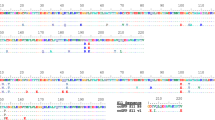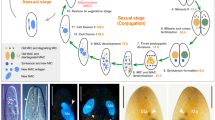Abstract
The use of genetic mutations to study protein functions in vivo is a central paradigm of modern biology. Recent advances in reverse genetics such as RNA interference and morpholinos are widely used to further apply this paradigm. Nevertheless, such systems act upstream of the proteic level, and protein depletion depends on the turnover rate of the existing target proteins. Here we present deGradFP, a genetically encoded method for direct and fast depletion of target green fluorescent protein (GFP) fusions in any eukaryotic genetic system. This method is universal because it relies on an evolutionarily highly conserved eukaryotic function, the ubiquitin pathway. It is traceable, because the GFP tag can be used to monitor the protein knockout. In many cases, it is a ready-to-use solution, as GFP protein-trap stock collections are being generated in Drosophila melanogaster and in Danio rerio.
This is a preview of subscription content, access via your institution
Access options
Subscribe to this journal
Receive 12 print issues and online access
$189.00 per year
only $15.75 per issue
Buy this article
- Purchase on Springer Link
- Instant access to full article PDF
Prices may be subject to local taxes which are calculated during checkout





Similar content being viewed by others
Accession codes
References
Inoue, T., Heo, W.D., Grimley, J.S., Wandless, T.J. & Meyer, T. An inducible translocation strategy to rapidly activate and inhibit small gtpase signaling pathways. Nat. Methods 2, 415–418 (2005).
Haruki, H., Nishikawa, J. & Laemmli, U.K. The anchor-away technique: rapid, conditional establishment of yeast mutant phenotypes. Mol. Cell 31, 925–932 (2008).
Rothbauer, U. et al. A versatile nanotrap for biochemical and functional studies with fluorescent fusion proteins. Mol. Cell. Proteomics 7, 282–289 (2008).
Schornack, S. et al. Protein mislocalization in plant cells using a gfp-binding chromobody. Plant J. 60, 744–754 (2009).
Pauli, A. et al. Cell-type-specific tev protease cleavage reveals cohesin functions in Drosophila neurons. Dev. Cell 14, 239–251 (2008).
Harder, B. et al. Tev protease-mediated cleavage in Drosophila as a tool to analyze protein functions in living organisms. Biotechniques 44, 765–772 (2008).
Dohmen, R.J., Wu, P. & Varshavsky, A. Heat-inducible degron: a method for constructing temperature-sensitive mutants. Science 263, 1273–1276 (1994).
Zhou, P., Bogacki, R., McReynolds, L. & Howley, P.M. Harnessing the ubiquitination machinery to target the degradation of specific cellular proteins. Mol. Cell 6, 751–756 (2000).
Sakamoto, K.M. et al. Protacs: chimeric molecules that target proteins to the skp1-cullin-f box complex for ubiquitination and degradation. Proc. Natl. Acad. Sci. USA 98, 8554–8559 (2001).
Zhang, J., Zheng, N. & Zhou, P. Exploring the functional complexity of cellular proteins by protein knockout. Proc. Natl. Acad. Sci. USA 100, 14127–14132 (2003).
Banaszynski, L.A., Chen, L.-C., Maynard-Smith, L.A., Ooi, A.G.L. & Wandless, T.J. A rapid, reversible, and tunable method to regulate protein function in living cells using synthetic small molecules. Cell 126, 995–1004 (2006).
Nishimura, K., Fukagawa, T., Takisawa, H., Kakimoto, T. & Kanemaki, M. An auxin-based degron system for the rapid depletion of proteins in nonplant cells. Nat. Methods 6, 917–922 (2009).
Taxis, C., Stier, G., Spadaccini, R. & Knop, M. Efficient protein depletion by genetically controlled deprotection of a dormant n-degron. Mol. Syst. Biol. 5, 267 (2009).
Ciechanover, A. The ubiquitin-proteasome pathway: on protein death and cell life. EMBO J. 17, 7151–7160 (1998).
Ciechanover, A. & Ben-Saadon, R. N-terminal ubiquitination: more protein substrates join in. Trends Cell Biol. 14, 103–106 (2004).
Jiang, J. & Struhl, G. Regulation of the hedgehog and wingless signalling pathways by the F-box/wd40-repeat protein slimb. Nature 391, 493–496 (1998).
Saerens, D. et al. Identification of a universal vhh framework to graft non-canonical antigen-binding loops of camel single-domain antibodies. J. Mol. Biol. 352, 597–607 (2005).
Rothbauer, U. et al. Targeting and tracing antigens in live cells with fluorescent nanobodies. Nat. Methods 3, 887–889 (2006).
Silljé, H.H.W., Nagel, S., Körner, R. & Nigg, E.A. Hurp is a ran-importin beta-regulated protein that stabilizes kinetochore microtubules in the vicinity of chromosomes. Curr. Biol. 16, 731–742 (2006).
Brand, A.H. & Perrimon, N. Targeted gene expression as a means of altering cell fates and generating dominant phenotypes. Development 118, 401–415 (1993).
Tabata, T., Eaton, S. & Kornberg, T.B. The Drosophila hedgehog gene is expressed specifically in posterior compartment cells and is a target of engrailed regulation. Genes Dev. 6, 2635–2645 (1992).
Caussinus, E., Colombelli, J. & Affolter, M. Tip-cell migration controls stalk-cell intercalation during Drosophila tracheal tube elongation. Curr. Biol. 18, 1727–1734 (2008).
Shaner, N.C., Steinbach, P.A. & Tsien, R.Y. A guide to choosing fluorescent proteins. Nat. Methods 2, 905–909 (2005).
Royou, A., Field, C., Sisson, J.C., Sullivan, W. & Karess, R. Reassessing the role and dynamics of nonmuscle myosin ii during furrow formation in early Drosophila embryos. Mol. Biol. Cell 15, 838–850 (2004).
Karess, R.E. et al. The regulatory light chain of nonmuscle myosin is encoded by spaghetti-squash, a gene required for cytokinesis in Drosophila. Cell 65, 1177–1189 (1991).
Young, P.E., Richman, A.M., Ketchum, A.S. & Kiehart, D.P. Morphogenesis in Drosophila requires nonmuscle myosin heavy chain function. Genes Dev. 7, 29–41 (1993).
Kiehart, D.P., Galbraith, C.G., Edwards, K.A., Rickoll, W.L. & Montague, R.A. Multiple forces contribute to cell sheet morphogenesis for dorsal closure in Drosophila. J. Cell Biol. 149, 471–490 (2000).
Gohl, D., Müller, M., Pirrotta, V., Affolter, M. & Schedl, P. Enhancer blocking and transvection at the Drosophila apterous locus. Genetics 178, 127–143 (2008).
Huang, J., Zhou, W., Dong, W., Watson, A.M. & Hong, Y. Directed, efficient, and versatile modifications of the Drosophila genome by genomic engineering. Proc. Natl. Acad. Sci. USA 106, 8284–8289 (2009).
Oda, H. & Tsukita, S. Real-time imaging of cell-cell adherens junctions reveals that Drosophila mesoderm invagination begins with two phases of apical constriction of cells. J. Cell Sci. 114, 493–501 (2001).
Morin, X., Daneman, R., Zavortink, M. & Chia, W. A protein trap strategy to detect gfp-tagged proteins expressed from their endogenous loci in Drosophila. Proc. Natl. Acad. Sci. USA 98, 15050–15055 (2001).
Kelso, R.J. et al. Flytrap, a database documenting a gfp protein-trap insertion screen in Drosophila melanogaster. Nucleic Acids Res. 32, D418–D420 (2004).
Buszczak, M. et al. The carnegie protein trap library: a versatile tool for Drosophila developmental studies. Genetics 175, 1505–1531 (2007).
Quiñones-Coello, A.T. et al. Exploring strategies for protein trapping in Drosophila. Genetics 175, 1089–1104 (2007).
Asakawa, K. & Kawakami, K. The tol2-mediated gal4-uas method for gene and enhancer trapping in zebrafish. Methods 49, 275–281 (2009).
Kawakami, K. et al. zTrap: zebrafish gene trap and enhancer trap database. BMC Dev. Biol. 10, 105 (2010).
Bischof, J., Maeda, R.K., Hediger, M., Karch, F. & Basler, K. An optimized transgenesis system for Drosophila using germ-line-specific phic31 integrases. Proc. Natl. Acad. Sci. USA 104, 3312–3317 (2007).
Warming, S., Costantino, N., Court, D.L., Jenkins, N.A. & Copeland, N.G. Simple and highly efficient bac recombineering using galk selection. Nucleic Acids Res. 33, e36 (2005).
Wodarz, A. Extraction and immunoblotting of proteins from embryos. Methods Mol. Biol. 420, 335–345 (2008).
Acknowledgements
We thank A. Santamaria, L. Fava and M. Müller for technical assistance; A. Olichon (Paul Sabatier University) for providing pAOD2-vhhGFP4; Y. Blum (University of Basel, UB) for providing pcDNA3_EGFP-3xNLS; E. Nigg (UB) for providing the HeLa S3 cell line expressing H2B-GFP; B. Bello (UB), W. Gehring (UB), C. Gonzalez (Institute for Research in Biomedicine), R. Karess (Institut Jacques Monod), T. Kornberg (University of California, San Francisco), Y. Hong (University of Pittsburgh), H. Oda (Biohistory Research Hall), R. Schuh (Max Planck Institute for Biophysical Chemistry) and the Bloomington Drosophila stock center (Indiana University), for providing fly stocks. E.C. was supported by an EMBO long-term postdoctoral fellowship (ALTF 737-2005). Work in our laboratory is supported by grants from the Kantons Basel-Stadt and Basel-Land, the Swiss National Science Foundation and the SystemsX.ch initiative within the framework of the WingX project.
Author information
Authors and Affiliations
Contributions
E.C. created the basic concept of deGradFP, designed all experiments and conducted all experiments except the ones depicted in Figure 4a and Supplementary Figure 3b,c. O.K. generated the ap::GFP flies and conducted the experiments depicted in Figure 4a and Supplementary Figure 3b,c. E.C., O.K. and M.A. wrote the manuscript.
Corresponding authors
Ethics declarations
Competing interests
The authors declare no competing financial interests.
Supplementary information
Supplementary Text and Figures
Supplementary Figures 1–3 and Supplementary Table 1 (PDF 572 kb)
Supplementary Movie 1
deGradFP mediates degradation of His2Av::EYFP in Drosophila. Confocal life imaging of an embryo having the following genotype, ubiHis2Av::EYFP; His2Av::RFP1/enGal4; UAS_NSlmb-vhhGFP4/+. Two channels, corresponding to His2Av::EYFP (green) and His2Av::RFP1 (red), were acquired simultaneously for better time resolution. Lateral views (z–stack maximum projections) were taken at 10 min intervals from stage 6 to 16. Anterior is to the left. Scale bar, 100 μm. (AVI 2570 kb)
Supplementary Movie 2
Wild type dorsal closure.Confocal life imaging of an embryo having the following genotype, sqhAX3; sqhSqh::GFP/+. Sqh::GFP appears in shades of gray. Dorsal views (z–stack maximum projections) were taken at 10 min intervals from stage 12 to 16. Anterior is to the left. Scale bar, 100 μm. (AVI 1851 kb)
Supplementary Movie 3
Sqh::GFP targeting by deGradFP in the amnioserosa cells causes a dorsal open phenotype.Confocal life imaging of an embryo having the following genotype, sqhAX3; sqhSqh::GFP/Gal4332.3; UAS_NSlmb–vhhGFP4/+. Sqh::GFP appears in shades of gray. Dorsolateral views (z–stack maximum projections) were taken at 10 min intervals from stage 12 to 16. Anterior is to the left. Scale bar, 100 μm. (AVI 2008 kb)
Rights and permissions
About this article
Cite this article
Caussinus, E., Kanca, O. & Affolter, M. Fluorescent fusion protein knockout mediated by anti-GFP nanobody. Nat Struct Mol Biol 19, 117–121 (2012). https://doi.org/10.1038/nsmb.2180
Received:
Accepted:
Published:
Issue Date:
DOI: https://doi.org/10.1038/nsmb.2180
This article is cited by
-
Proteome-scale discovery of protein degradation and stabilization effectors
Nature (2024)
-
Ana1/CEP295 is an essential player in the centrosome maintenance program regulated by Polo kinase and the PCM
EMBO Reports (2024)
-
Extreme thermal stability of the antiGFP nanobody – GFP complex
BMC Research Notes (2023)
-
Camels’ biological fluids contained nanobodies: promising avenue in cancer therapy
Cancer Cell International (2022)
-
PROTAC targeted protein degraders: the past is prologue
Nature Reviews Drug Discovery (2022)



